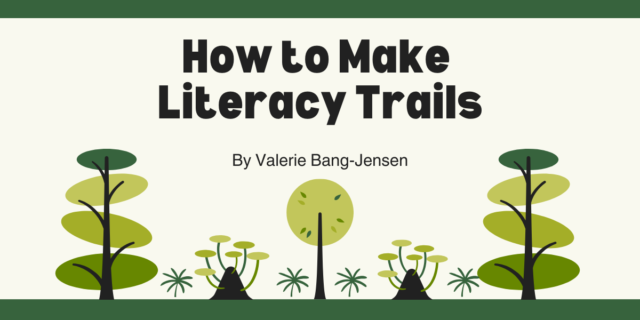
The following is adapted from Valerie Bang-Jensen’s Literacy Moves Outdoors.
When the opportunity arises, seize the moment to move literacy outside. Here you’ll find suggestions for developing literacy backpacks and kits full of books, guides, and writing implements based on themes. Guidelines for gathering materials, determining routines, and setting the foundation for behavior outdoors are offered.
Be spontaneous when the weather is right
It’s the first sunny day after a drab few weeks and everyone wants to get outside. You grab your current read-aloud—novel or picture book—and head outside with your class. The students settle in, eager to hear the next chapter, and you all enjoy the change of setting. You’ve just moved literacy outside in a spontaneous moment. In this chapter, you’ll find ways to get outside with your class on the spur of the moment with almost no planning, to other ways that will be easy to launch once you’ve done some preparation for materials and routines ahead of time. Somewhat surprisingly, the secret to spontaneity is planning! I am more likely to get in my daily walk when I know where my sneakers are, have my step counter strapped to my wrist, my podcasts queued up, and my water bottle filled. With everything in place, it’s easy to seize the moment and get outdoors, and to be honest, I’m more likely to do it. The same idea is true in an artist’s studio and a biologist’s lab. When materials are set up, whether it be the microscope, sterilized petri dishes, and specimens, or paint palette, brushes, canvas, and lighting, when everything is always ready, we can move seamlessly into the work at hand.
Planning for literacy outdoors will enable you to be spontaneous when the weather cooperates or opportunities arise. The rain has stopped? The art teacher has gone home sick? Schedules change at the last minute on a regular basis for a variety of reasons. With all the materials ready and logistics taken care of ahead of time you’ll be ready to seize the moment.
Prep “grab and go” bags of books and writing supplies
A busy teacher friend once told me that she dreamed of a preloaded literacy backpack she could grab to head outside with her class when the weather turned nice. In her fantasy, maybe it would relate to her curriculum, maybe not, but the books and related activities inside would help her class enjoy being outside and continue their learning. Once outside, she would pull out an engaging book, some simple supplies to launch discussion and exploration, and the tools needed to support creating, recording, and imagining. Having a backpack at the ready can set you and your students up for a predictable literacy routine that can grow and change along with your goals. One backpack for the teacher might morph into numerous backpacks shared by partners or small groups; you might eventually have enough for each student to choose an individual backpack with books and materials based on a theme like clouds or insects.
What might go in my friend’s imagined backpack? Books. You might create a backpack around a theme, an author or illustrator, or one special book that your students will find immediately inspiring.
You probably are thinking of just the right book to take outside, but here are a few titles to get you started:
- Clouds: It Looked Like Spilt Milk (Shaw)
- Rocks: Everybody Needs A Rock (Baylor), and When You Find the Right Rock (Ray)
- Big Questions and Small Observations: Wonder Walkers (Archer), and Tiny, Perfect Things (Clark)
- Birds: Everyday Birds (VanDerwater), Mama Built A Nest (Ward), and A Nest Is Noisy (Aston)
- Trees: Nell Plants A Tree (Wynter), Be A Tree (Gianferrari), Tell Me Tree (Gibbons)
What else goes into the backpack?
It’s helpful to think of two general ideas:
- First, what will support literacy, literally? Be sure that you include writing implements, paper or journals, and clipboards; alternatively, you could bring individual student materials bins.
- Second, what will you want students to do after reading? What materials will invite you all to explore this topic in an immediate way? A cloud-themed backpack might include blue construction paper, white crayons, pastels, or chalk, or even cotton balls. A rock- or stone-themed backpack could have a portable Mancala game, a hand-held magnifying lens, and a field guide for identifying stones. Think about materials that will be manageable and will help you deepen the experience. Vermont’s Shelburne Farms offers backpacks for visitors to the children’s farmyard that provide a similar experience. In a smart move, there is a list of the contents with just enough description for users to know what their choices are and to help users keep the right materials with the right backpack.

Valerie Bang-Jensen is Professor of Education at Saint Michael's College, where she has earned the college’s Rathgeb Teaching Award. She received her A.B. at Smith College and MA, M.Ed., and Ed.D. degrees from Teachers College, Columbia University. Valerie has taught in K-6 classrooms and library programs in public and independent schools in the U.S. and Paris, and was the district elementary writing coordinator in Ithaca, New York. She serves as a consultant for museums, libraries, schools and gardens for children. Valerie's areas of interest include children's literature, nonfiction, and connections between literacy and first-hand experiences. Valerie co-founded the Teaching Gardens of Saint Michael’s College, including one called Books in Bloom, which features flowers found in children’s books.


